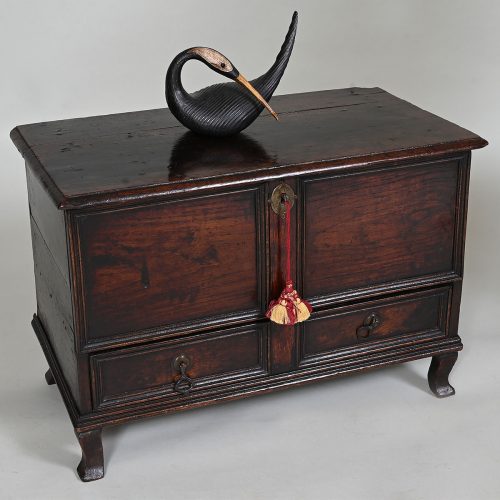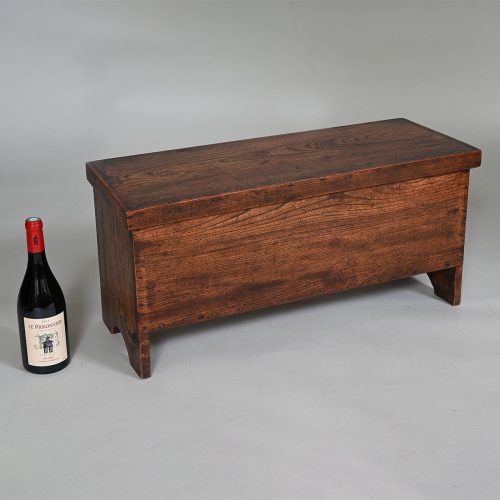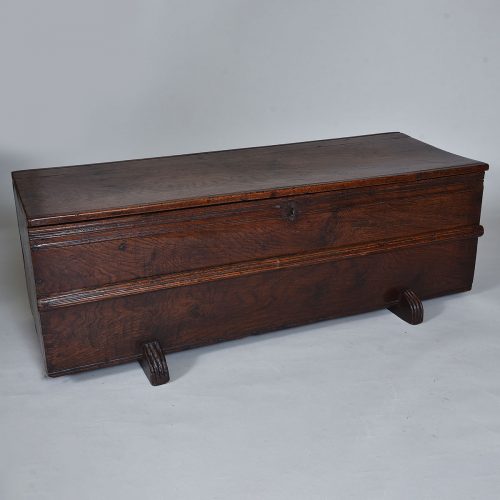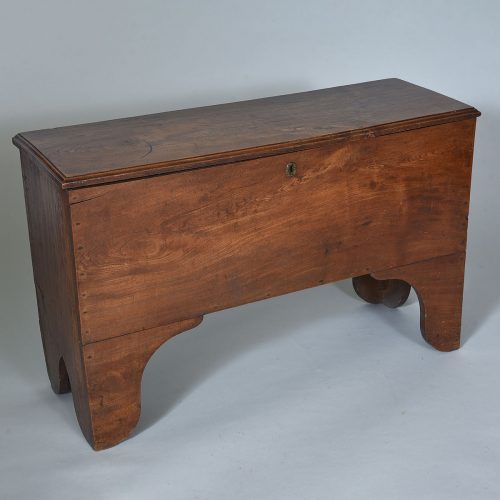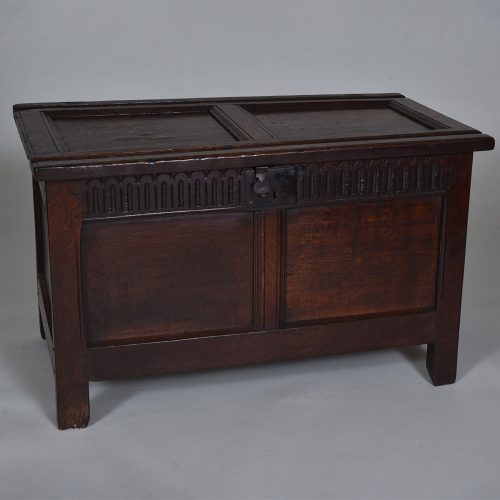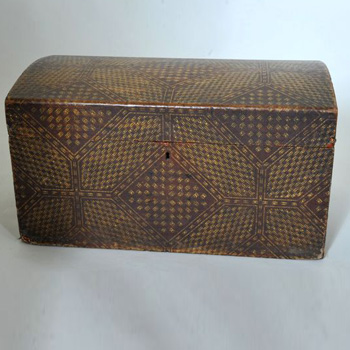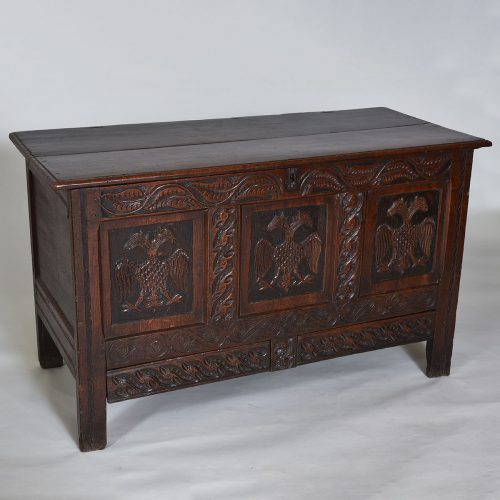Coffers & Chests
-
18th Century Welsh Oak Coffer Bach
£1,950.00Mid 18th century Welsh Oak coffer bach or marriage/dowry chest. The lifting lid on lopers. The front with three shaped and fielded square panels. A single long drawer over bracket feet. Circa 1750 Width: 27.5" / 69 cms Depth: 14" / 36 cms Height: 21.5" / 54 cms -
Rare 18th century Welsh Oak Coffer Bach
£1,450.00Mid 18th century Welsh Oak coffer bach or marriage/dowry chest. The lifting lid having a moudled edge and on lopers. The front with split moulding forming two panels above single long drawer again with split moulding. Very unusual short cabriole legs with feet reminiscent of American furniture. Circa 1740 Width: 27.5" / 69 cms Depth: 14" / 36 cms Height: 21.5" / 54 cms -
Very unusual child's or miniature Elm coffer. This could also have been a sample piece. The top with moulding sits on the coffer with no hinges or lopers. I have never seen anything similar. Circa 1800 Width: 29" / 74 cms Depth: 11.5" / 29 cms Height: 14" / 35 cms
-
17th century Continental Oak Coffer
£1,250.0017th century low oak Continental coffer on original sledge feet and retaining interior till. This coffer is very similar to chests from the Avesnes/Thiérache area of Eastern Picardy which date from the 1650-1725 period. The mid height moulding, sledge feet and construction are very similar. In St Andrew’s Church, Wickhambreaux, Kent there is a chest which bears a resemblance to these examples. Possibly the Kent chest was made in France and imported or that the chest was made by an immigrant craftsman. From 1681-1685 a large number of Huguenot refuges came to England which may explain this. Width: 54" / 137 cms Depth: 19" / 48 cms Height: 19" / 48 cms -
17th century Oak Chest of Drawers
£1,650.0017th century Oak chest of drawers in two parts. The graduated drawers with geometric moulding. Original condition. Width: 38.5" / 98 cms Depth: 21.5" / 55 cms Height: 37.5" / 96 cms -
Elm Coffer circa 1800
£690.00Narrow, small Elm coffer - circa 1800. Original hinges. Width: 39" / 100 cms Depth: 132 / 33 cms Height: 24" / 61 cms -
Walnut Bureau in the Queen Anne Style
£1,650.00Queen Anne Style Walnut bureau with good faded colour and patination. Fall front revealing a well with sliding cover with leather sciver and an arrrangmenet of pigeon holes Width: 31" / 79 cms Depth:17.75" / 45 cms Height: 33" / 84 cms -
Small 17th century Oak coffer
£650.00Small 17th century Oak coffer of a mortice and tennon constuction. Inset two panel top over a carved frieze and two inset panels to the front. Circa 1680. Width: 37.5" / 95 cms Depth: 19.5" / 50 cms Height: 22.5" / 57 cms -
18th century Mahogany Chest of Drawers
£1,250.0018th century Mahogany Chest of Drawers with brushing slide and moulded top over four graduated drawers on shaped, bracket feet. English. Circa 1780 Width: 32.5" / 83 cms Depth: 18.5" / 47 cms Height: 31.5" / 80 cms -
Georgian Mahogany Chest of Drawers
£1,650.00Late 18th century Mahogany chest of drawers with brushing slide. Circa 1780/90. English Two short drawers over three long drawers on bracket feet. Original handles. Width: 35.5" / 90 cms Depth: 20" / 51 cms Height: 33" / 84 cms -
19th Century Antique Trunk
£425.0019th century trunk with embossed/painted textile covering. Water gilded handles. Width: 25.5” / 64 cm Depth: 15” / 38 cm Height: 14.5” / 37 cm -
SOLDRare 17th century Oak Coffer with Blind Drawers - Salisbury Width: 53" / 135 cms Depth: 22" / 56 cms Height: 31" / 79 cms
17th century Oak Coffer with Two Drawers – Possibly carved by the workshop of Humphrey Beckham, Salisbury.
The Coat of Arms of the double headed eagle belongs to the Speke Family. The Speke Family originated from a village Quettehou near Cherbourg in Normandy, settling in England sometime after the Norman Invasion. First records were of a Richard L’Espec born 1110 living in North Devon at Wembworthy. Their estate was called Heywood (today the site of New Eggesford House) Walter Espec (died 1153) was Sheriff of Yorkshire and feudal baron of Helmsley in Yorkshire, built Helmsley Castle, Wark Castle and founded Kirkham Priory and Rievaulx Abbey. Sir John Speke (1442–1518) of Whitelackington, Somerset, was Sheriff of Devon in 1517 and a Member of Parliament (1477) He was knighted in 1501. His monument is the Speke Chantry in Exeter Cathedral in which survives his recumbent effigy. Sir George Speke (1530-1584) had ties to North Yorkshire – he married Elizabeth Luttrell, widow of Richard Mallet of Currypool, the daughter of Sir Andrew Luttrell (1484–1538), feudal baron of Dunster, of Dunster Castle in Somerset, Sheriff of Somerset and Dorset in 1528 by his wife Margaret Wyndham (d.1580), a daughter of Sir Thomas Wyndham (d.1521) of Felbrigg Hall, Norfolk, by his first wife Eleanor Scrope, daughter and heiress of Richard Scrope of Upsall Castle, Yorkshire. By Elizabeth he had a son and two daughters. George Speke (1623-1689) was a supporter of Prince Rupert at Bridgewater. When the town surrendered to Thomas Fairfax in July 1645 he was taken as a hostage and sent to the Tower of London to the Gatehouse Prison. He was released on payment of the sum of £2390 in 1646. From 1661–1662 he served as High Sheriff of Somerset until, in August 1679, he was elected M.P. for Somerset. The precise date of this coffer is difficult to establish. The top rail is carved with leaves depicted in a naturalistic way and is almost identical to that found on the frieze of a table dated circa 1675 - illustrated in Anthony Wells-Cole’s article from the Furniture History Volume XII 1976 Fig 10c Oak Furniture in Dorset. The carving of the double headed eagle on the front three panels is similar to that which can be found on an armchair on the front cover of ‘Oak Furniture – The British Tradition’ by Victor Chinnery – This chair was carved by Humphrey Beckham (1588-1671) and dated 1622 – the back panel bearing the arms of the City of New Sarum (Salisbury) which includes the double headed eagle. It is known that carvers from the workshop in Salisbury crossed the borders to Dorset to work at Chantmarle House– see above. The deep carving to the two drawer fronts is similar to that found on a joined stool with drawer circa 1630 (Page 229 Fig 3:113 Salisbury. A joint stool (dated circa 1630) with a carved frieze rail of scrolling forms Page 152 Fig.2:215 bears a resemblance to the carved rail below the three panelled front. The hinges are a later replacement.



